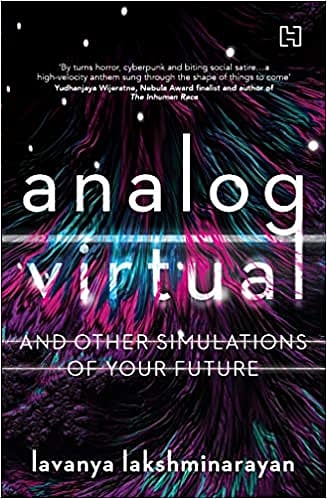Future Present

Dystopia is already here and speculative science fiction doesn’t have to vie too hard to come under current affairs. If that’s worrying, it should, because the world as we know is changing rapidly. Lavanya Lakshminarayan’s debut work of fiction, Analog Virtual, is set in some unnamed point in the future where nations have fallen and corporations are running the world, and it views one city through this lens—Apex City, or what used to formerly be Bangalore which is now run by the Bell Corporation.
The idea that merit should be the basis of success is not new, and a version of this has been used before in Yudhanjaya Wijeratne’s Numbercaste. But the similarities end there, as Lakshminarayan’s story is simpler and yet, more layered with a rich collection of memorable characters. The connection that the stories and characters create is also more immediate and hard hitting.
The Carnatic Meridian, a crackling electric fence divides the city into the Analog half—where life is still primitive and people don’t have access to technology and the Virtual half—where people have allowed technology to become intrinsic to their lives. In this new world order, the twenty percenters are at the very top of the famed Bell Curve and they get the best of everything and lead an enviable life while the seventy percenters continue to trudge along, hoping their unflinching productivity will propel them into that sacrosanct sphere at the top. The bottom ten percenters however, are the Analogs, who live cringeworthy lives, using paper money and continuing with face-to-face interactions, living without ClimaTech or OmniPorts and various other technological advances that have made life a breeze for the Virtuals.
2026 New Year Issue
Essays by Shashi Tharoor, Sumana Roy, Ram Madhav, Swapan Dasgupta, Carlo Pizzati, Manjari Chaturvedi, TCA Raghavan, Vinita Dawra Nangia, Rami Niranjan Desai, Shylashri Shankar, Roderick Matthews, Suvir Saran
The collection of twenty short stories with different characters paints a lucid picture of the future and several of the characters recur in other stories. There’s Nayaka, the infallible ten-percent-thief who brings a real jacaranda tree to the Analog side, Anita, a working drone who has been demoted to living an Analog life briefly, and hates every second of it, John, who wants to reach the top twenty percent has to file (literally) his interest in the Outside and his love for digital music, Teresa who takes the children of the Virtuals on school tours into dangerous Analog territory on a Maglev train while unobtrusively searching for her missing sister who was deported to the Analog side or even her sister Marie who plays a huge role in the resistance that is coming up against the all-powerful Bell Corp.
Every story adds another layer, showcasing different aspects of the lives of the Apex City residents, and added to this intriguing mix is being able to recognise different parts of Bangalore, some of which are named overtly and some, which are left to the reader to guess. The new roles that they play in this brave, new world are equally fascinating. As the stories run into each other, there’s a slow build-up of tension. What will happen to the efforts of the Analogs? Will the junk yard/Jewel Tree garden that they’ve built siphon technology from the Virtuals when the time is right? Or will the Virtuals continue to remain all powerful and entitled?
It’s also difficult to choose favourites because there’s something meaty to sink your teeth into, in every story. Whether it’s the story about Nina, the musician who is an Analog orphan, adopted by Virtuals and trying to be accepted in the story Etudes or the one about the retired Virtuals living their structured lives in Time, or the quirky hyper reality in the Be-Emoji project, the stories about the Virtuals are tied in equally with the stories of the Analogs who are planning their revolt. Connecting these two realities is the underlying, all-knowing Nebula. To reveal more would be a disservice to the immense craft that has gone into creating this altogether chilling and possibly real world.

